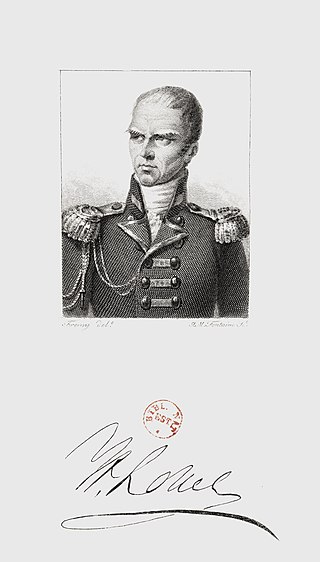
The Hôtel des Invalides, commonly called Les Invalides, is a complex of buildings in the 7th arrondissement of Paris, France, containing museums and monuments, all relating to the military history of France, as well as a hospital and a retirement home for war veterans, the building's original purpose. The buildings house the Musée de l'Armée, the military museum of the Army of France, the Musée des Plans-Reliefs, and the Musée d'Histoire Contemporaine. The complex also includes the former hospital chapel, now national cathedral of the French military, and the adjacent former Royal Chapel known as the Dôme des Invalides, the tallest church building in Paris at a height of 107 meters. The latter has been converted into a shrine of some of France's leading military figures, most notably the tomb of Napoleon.

Jeanne Françoise Julie Adélaïde Récamier, known as Juliette, was a French socialite whose salon drew people from the leading literary and political circles of early 19th-century Paris. An icon of neoclassicism, Récamier cultivated a public persona as a great beauty, and her fame quickly spread across Europe. She befriended many intellectuals, sat for the finest artists of the age, and spurned an offer of marriage from Prince Augustus of Prussia.

Gaspard, Baron Gourgaud, also known simply as Gaspard Gourgaud, was a French soldier, prominent in the Napoleonic wars.

Charles Tristan, Marquis de Montholon was a French general during the Napoleonic Wars. He chose to go into exile on Saint Helena with the ex-emperor after Napoleon's second abdication.

Sir Hudson Lowe was an Anglo-Irish soldier and colonial administrator who is best known for his time as Governor of St Helena, where he was the "gaoler" of the Emperor Napoleon.

Louis Marie Jacques Amalric, comte de Narbonne-Lara was a French nobleman, soldier and diplomat.

Monsieur N. is a 2003 British-French film directed by Antoine de Caunes. It tells the story of the last years of the life of the Emperor Napoléon, who was imprisoned by the British on St Helena. Napoléon retained a loyal entourage of officers who helped him plot his escape, and evaded the attentions of Major-General Sir Hudson Lowe, the island's overzealous Governor.

Napoleon is a 2002 historical miniseries which explored the life of Napoleon Bonaparte. It was the most expensive television miniseries in Europe up to that time, costing an equivalent of (USD) $46,330,000 to produce. The miniseries covered Napoleon's military successes and failures, including the battles of Austerlitz, Eylau, and Waterloo and the retreat from Russia. It also delved into Napoleon's personal life: his marriage to and divorce from Josephine de Beauharnais, his marriage to Marie Louise, the Duchess of Parma and daughter of Francis II, and his affairs with Eleanore Denuelle and Marie Walewska. The series draws from Max Gallo's biography.

Eagle in a Cage is an Anglo-American historical drama film, released in 1971.

Napoléon is a 1955 French historical epic film directed by Sacha Guitry that depicts major events in the life of Napoleon.

Royal Affairs in Versailles is a 1954 French-Italian historical drama directed by Sacha Guitry. Described as "a historical film showing Versailles from its beginnings to the present day", it tells some episodes through portrayal of the personalities who lived in the Palace of Versailles. Its sister films are Napoléon (1955) and If Paris Were Told to Us (1956).
Events from the year 1803 in France.
Events from the year 1800 in France.

The Pearls of the Crown is a 1937 French comedy film of historically based fiction by Sacha Guitry who plays four roles in it. Guitry's Jean Martin investigates the history of seven pearls, four of which end up on the crown of England, while the other three initially go missing.
St Helena: a play in twelve scenes is a play by the English author R. C. Sherriff and Jeanne de Casalis. It deals with the exile of Napoleon I on Saint Helena. In a production by Henry Cass, it premiered at the Old Vic on 4 February 1936 to poor reviews, but was rescued by a letter to The Times by Winston Churchill, calling it "a remarkable play" and "a work of art of a very high order"; though a West End transfer also proved unsuccessful.

François Carlo Antommarchi was Napoleon's physician from 1819 to his death in 1821.

Napoleon II, the Eagle (French: Napoléon II, l'Aiglon, in English Napoleon II, the eaglet is a 1961 French historical drama film directed by Claude Boissol and starring Bernard Verley, Jean Marais and Danièle Gaubert. The scenario was written by Paul Andréota and based on a novel of André Castelot. The film's sets were designed by the art director Wolf Witzemann.

Charles François Frédéric de Montholon-Sémonville was a French senator, diplomat, and French ambassador to the United States from 1864 to 1866.

Napoleon at Saint Helena is a 1929 German silent historical film directed by Lupu Pick and starring Werner Krauss, Hanna Ralph, and Albert Bassermann.

The Valley of the Tomb is the site of Napoleon's tomb, on the British Overseas Territory of Saint Helena in the south Atlantic Ocean, where he was buried following his death in exile on 5 May 1821. The valley had been called the Sane Valley, but Napoleon had taken walks there and referred to it as the Valley of the Geraniums.
















